Human Resource Development Report: Green & Company
VerifiedAdded on 2020/01/06
|22
|5393
|209
Report
AI Summary
This report provides a comprehensive analysis of Human Resource Development (HRD) practices within Green & Company, a family-owned shoe manufacturing business. The report begins with an introduction to HR management and its significance in enhancing employee efficiency and performance. Task 1 delves into different learning styles (Kolb, VARK, Myers Briggs, Honey and Mumford) and their application in induction training, including a detailed two-day induction program for new employees. Task 2 compares the training needs of different employee levels (line managers, graduate trainees, and senior managers) and evaluates the advantages and disadvantages of various training methods, proposing a training and development plan. Task 3 focuses on the evaluation of the induction training program, exploring techniques for assessing its success. Finally, Task 4 examines the role of the UK government in training and development, including competency-based assessments and contemporary initiatives. The report concludes with a summary of the key findings and recommendations for improving HRD practices at Green & Company.

HRD
Paraphrase This Document
Need a fresh take? Get an instant paraphrase of this document with our AI Paraphraser
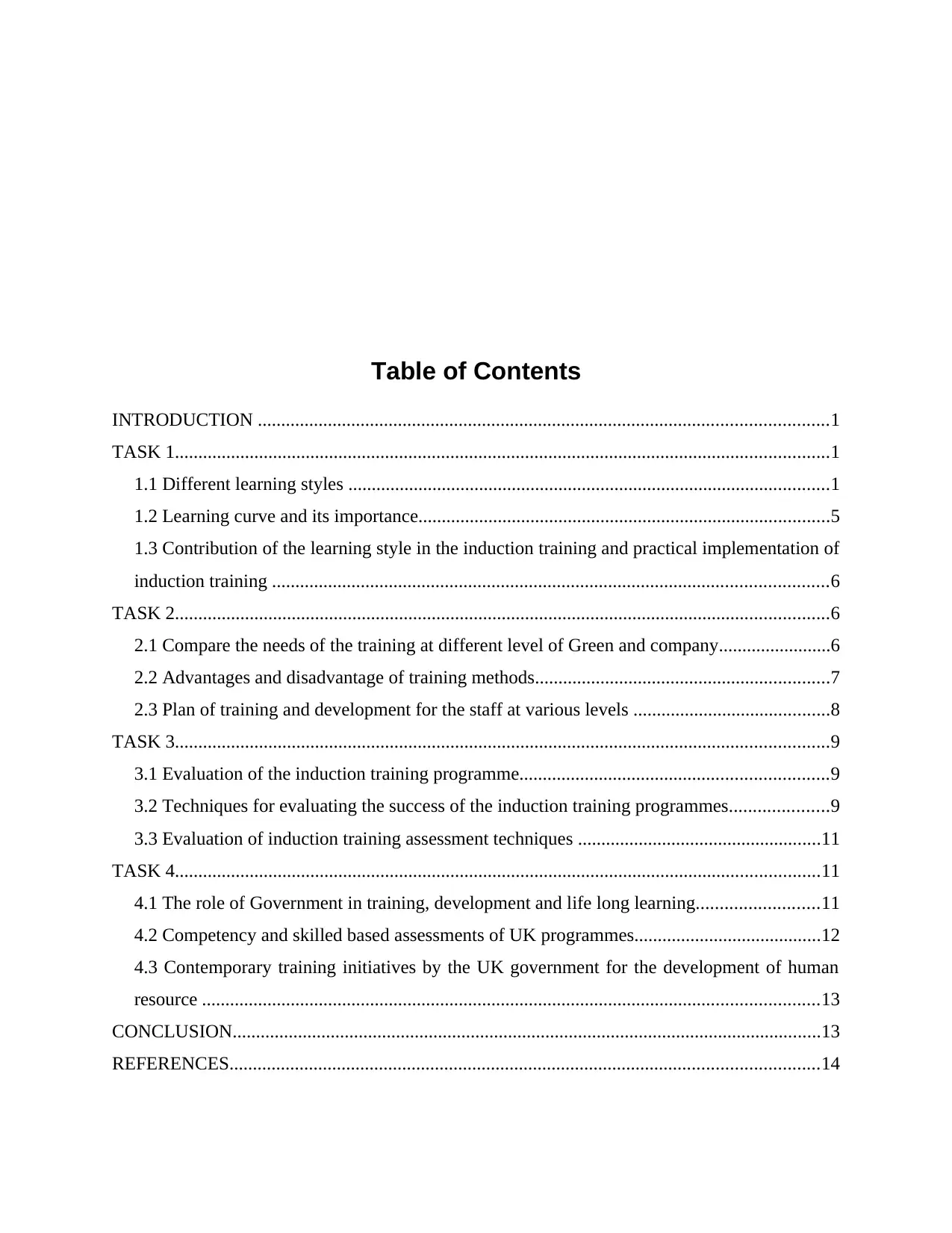
Table of Contents
INTRODUCTION ..........................................................................................................................1
TASK 1............................................................................................................................................1
1.1 Different learning styles .......................................................................................................1
1.2 Learning curve and its importance........................................................................................5
1.3 Contribution of the learning style in the induction training and practical implementation of
induction training .......................................................................................................................6
TASK 2............................................................................................................................................6
2.1 Compare the needs of the training at different level of Green and company........................6
2.2 Advantages and disadvantage of training methods...............................................................7
2.3 Plan of training and development for the staff at various levels ..........................................8
TASK 3............................................................................................................................................9
3.1 Evaluation of the induction training programme..................................................................9
3.2 Techniques for evaluating the success of the induction training programmes.....................9
3.3 Evaluation of induction training assessment techniques ....................................................11
TASK 4..........................................................................................................................................11
4.1 The role of Government in training, development and life long learning..........................11
4.2 Competency and skilled based assessments of UK programmes........................................12
4.3 Contemporary training initiatives by the UK government for the development of human
resource ....................................................................................................................................13
CONCLUSION..............................................................................................................................13
REFERENCES..............................................................................................................................14
INTRODUCTION ..........................................................................................................................1
TASK 1............................................................................................................................................1
1.1 Different learning styles .......................................................................................................1
1.2 Learning curve and its importance........................................................................................5
1.3 Contribution of the learning style in the induction training and practical implementation of
induction training .......................................................................................................................6
TASK 2............................................................................................................................................6
2.1 Compare the needs of the training at different level of Green and company........................6
2.2 Advantages and disadvantage of training methods...............................................................7
2.3 Plan of training and development for the staff at various levels ..........................................8
TASK 3............................................................................................................................................9
3.1 Evaluation of the induction training programme..................................................................9
3.2 Techniques for evaluating the success of the induction training programmes.....................9
3.3 Evaluation of induction training assessment techniques ....................................................11
TASK 4..........................................................................................................................................11
4.1 The role of Government in training, development and life long learning..........................11
4.2 Competency and skilled based assessments of UK programmes........................................12
4.3 Contemporary training initiatives by the UK government for the development of human
resource ....................................................................................................................................13
CONCLUSION..............................................................................................................................13
REFERENCES..............................................................................................................................14

⊘ This is a preview!⊘
Do you want full access?
Subscribe today to unlock all pages.

Trusted by 1+ million students worldwide
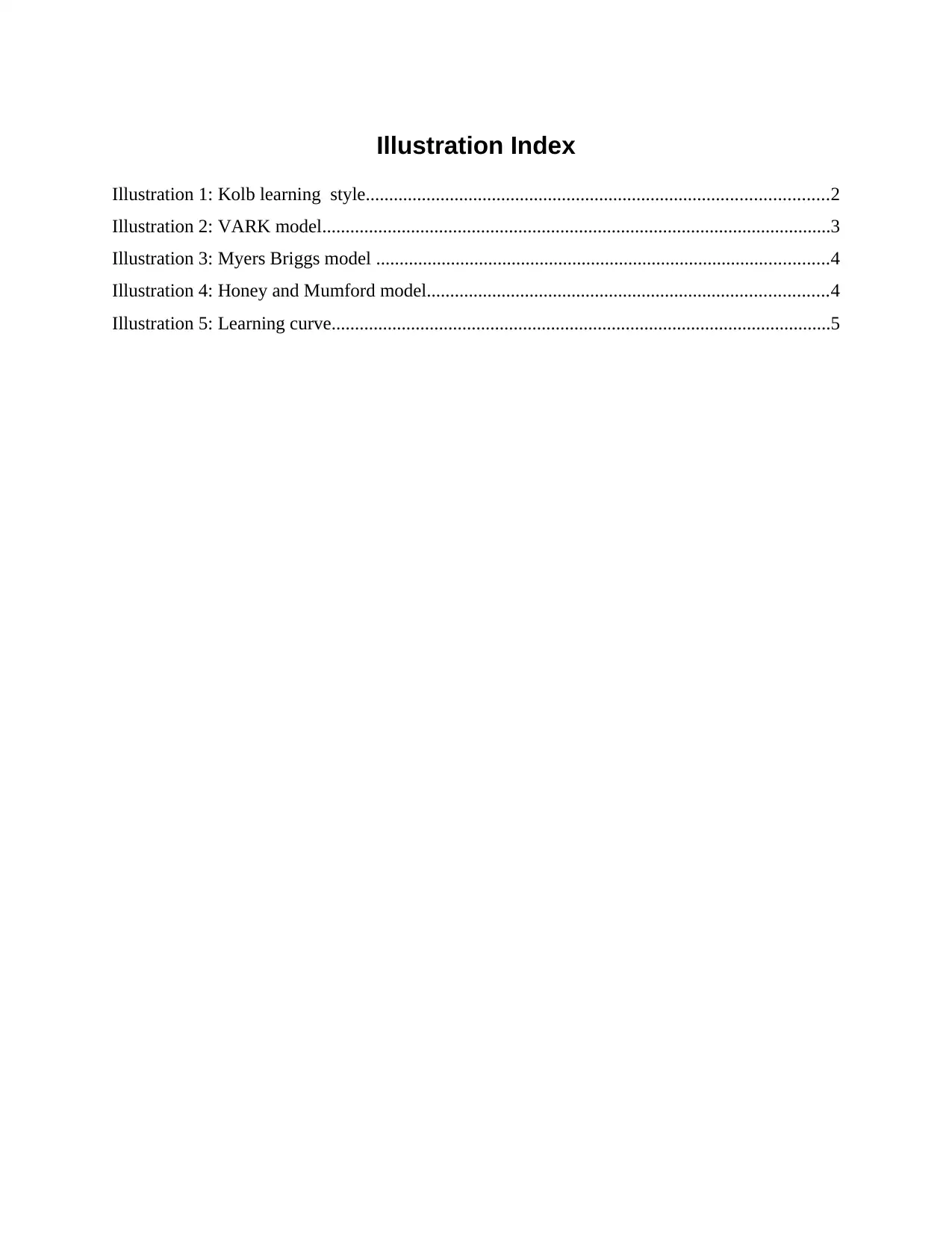
Illustration Index
Illustration 1: Kolb learning style...................................................................................................2
Illustration 2: VARK model.............................................................................................................3
Illustration 3: Myers Briggs model .................................................................................................4
Illustration 4: Honey and Mumford model......................................................................................4
Illustration 5: Learning curve...........................................................................................................5
Illustration 1: Kolb learning style...................................................................................................2
Illustration 2: VARK model.............................................................................................................3
Illustration 3: Myers Briggs model .................................................................................................4
Illustration 4: Honey and Mumford model......................................................................................4
Illustration 5: Learning curve...........................................................................................................5
Paraphrase This Document
Need a fresh take? Get an instant paraphrase of this document with our AI Paraphraser
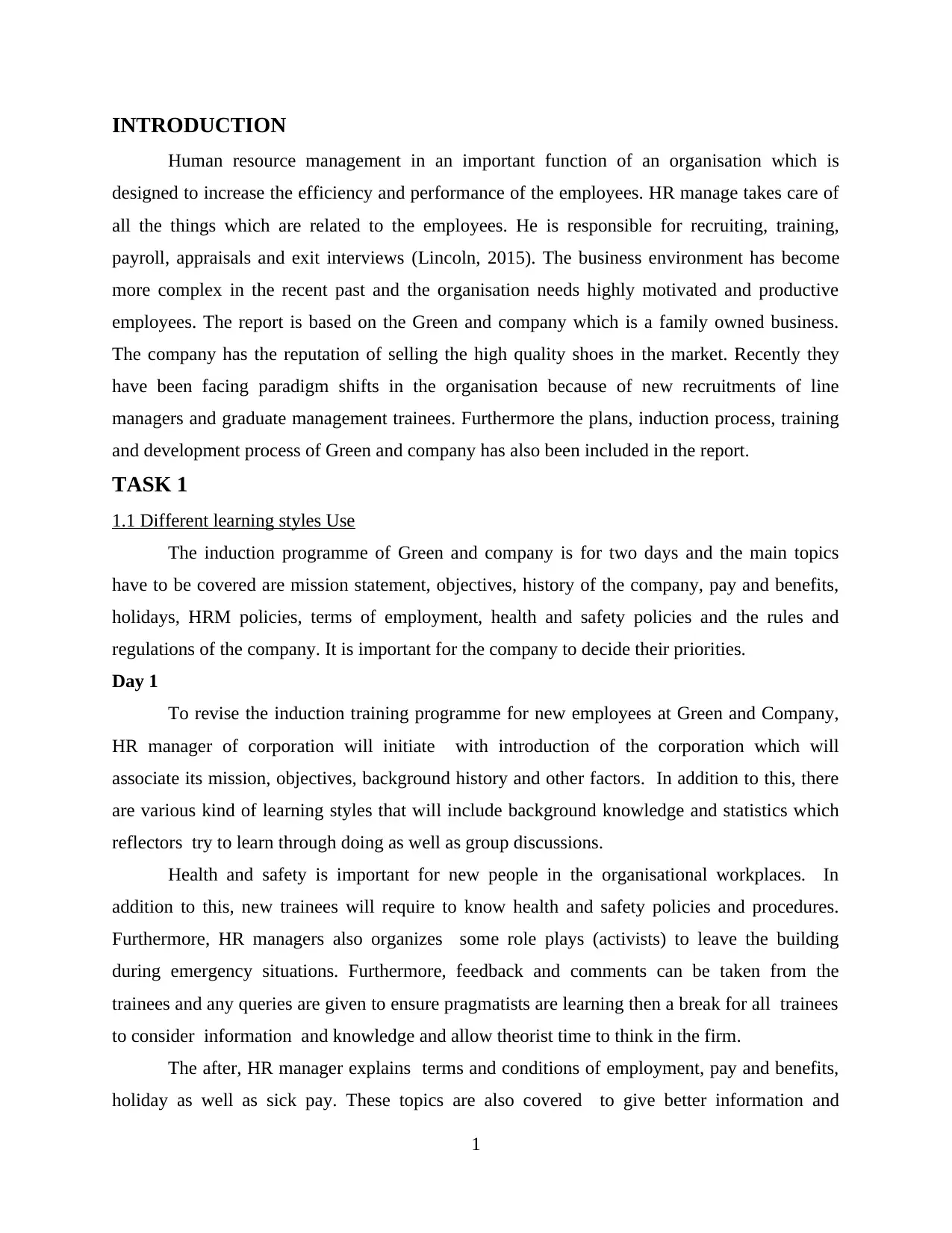
INTRODUCTION
Human resource management in an important function of an organisation which is
designed to increase the efficiency and performance of the employees. HR manage takes care of
all the things which are related to the employees. He is responsible for recruiting, training,
payroll, appraisals and exit interviews (Lincoln, 2015). The business environment has become
more complex in the recent past and the organisation needs highly motivated and productive
employees. The report is based on the Green and company which is a family owned business.
The company has the reputation of selling the high quality shoes in the market. Recently they
have been facing paradigm shifts in the organisation because of new recruitments of line
managers and graduate management trainees. Furthermore the plans, induction process, training
and development process of Green and company has also been included in the report.
TASK 1
1.1 Different learning styles Use
The induction programme of Green and company is for two days and the main topics
have to be covered are mission statement, objectives, history of the company, pay and benefits,
holidays, HRM policies, terms of employment, health and safety policies and the rules and
regulations of the company. It is important for the company to decide their priorities.
Day 1
To revise the induction training programme for new employees at Green and Company,
HR manager of corporation will initiate with introduction of the corporation which will
associate its mission, objectives, background history and other factors. In addition to this, there
are various kind of learning styles that will include background knowledge and statistics which
reflectors try to learn through doing as well as group discussions.
Health and safety is important for new people in the organisational workplaces. In
addition to this, new trainees will require to know health and safety policies and procedures.
Furthermore, HR managers also organizes some role plays (activists) to leave the building
during emergency situations. Furthermore, feedback and comments can be taken from the
trainees and any queries are given to ensure pragmatists are learning then a break for all trainees
to consider information and knowledge and allow theorist time to think in the firm.
The after, HR manager explains terms and conditions of employment, pay and benefits,
holiday as well as sick pay. These topics are also covered to give better information and
1
Human resource management in an important function of an organisation which is
designed to increase the efficiency and performance of the employees. HR manage takes care of
all the things which are related to the employees. He is responsible for recruiting, training,
payroll, appraisals and exit interviews (Lincoln, 2015). The business environment has become
more complex in the recent past and the organisation needs highly motivated and productive
employees. The report is based on the Green and company which is a family owned business.
The company has the reputation of selling the high quality shoes in the market. Recently they
have been facing paradigm shifts in the organisation because of new recruitments of line
managers and graduate management trainees. Furthermore the plans, induction process, training
and development process of Green and company has also been included in the report.
TASK 1
1.1 Different learning styles Use
The induction programme of Green and company is for two days and the main topics
have to be covered are mission statement, objectives, history of the company, pay and benefits,
holidays, HRM policies, terms of employment, health and safety policies and the rules and
regulations of the company. It is important for the company to decide their priorities.
Day 1
To revise the induction training programme for new employees at Green and Company,
HR manager of corporation will initiate with introduction of the corporation which will
associate its mission, objectives, background history and other factors. In addition to this, there
are various kind of learning styles that will include background knowledge and statistics which
reflectors try to learn through doing as well as group discussions.
Health and safety is important for new people in the organisational workplaces. In
addition to this, new trainees will require to know health and safety policies and procedures.
Furthermore, HR managers also organizes some role plays (activists) to leave the building
during emergency situations. Furthermore, feedback and comments can be taken from the
trainees and any queries are given to ensure pragmatists are learning then a break for all trainees
to consider information and knowledge and allow theorist time to think in the firm.
The after, HR manager explains terms and conditions of employment, pay and benefits,
holiday as well as sick pay. These topics are also covered to give better information and
1
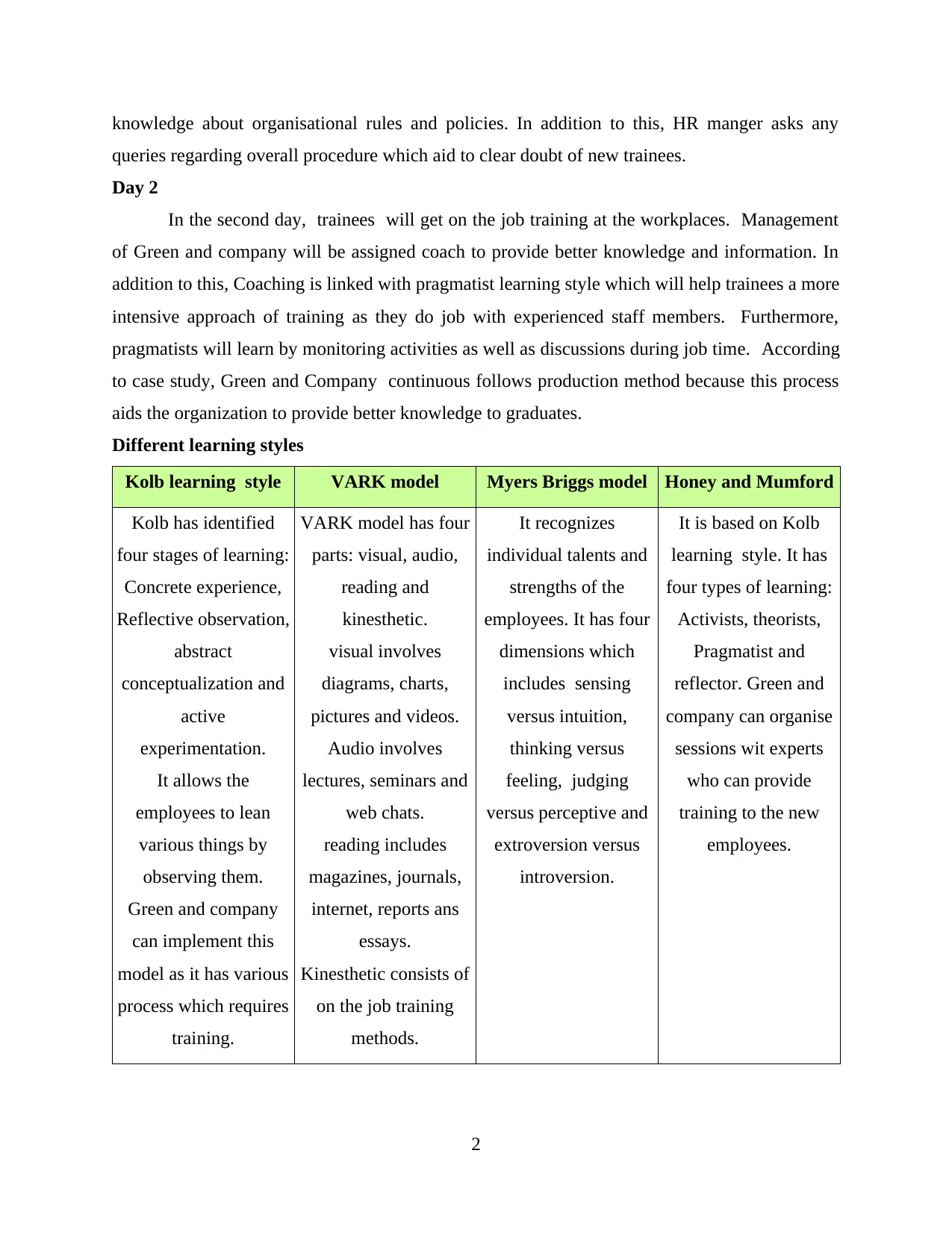
knowledge about organisational rules and policies. In addition to this, HR manger asks any
queries regarding overall procedure which aid to clear doubt of new trainees.
Day 2
In the second day, trainees will get on the job training at the workplaces. Management
of Green and company will be assigned coach to provide better knowledge and information. In
addition to this, Coaching is linked with pragmatist learning style which will help trainees a more
intensive approach of training as they do job with experienced staff members. Furthermore,
pragmatists will learn by monitoring activities as well as discussions during job time. According
to case study, Green and Company continuous follows production method because this process
aids the organization to provide better knowledge to graduates.
Different learning styles
Kolb learning style VARK model Myers Briggs model Honey and Mumford
Kolb has identified
four stages of learning:
Concrete experience,
Reflective observation,
abstract
conceptualization and
active
experimentation.
It allows the
employees to lean
various things by
observing them.
Green and company
can implement this
model as it has various
process which requires
training.
VARK model has four
parts: visual, audio,
reading and
kinesthetic.
visual involves
diagrams, charts,
pictures and videos.
Audio involves
lectures, seminars and
web chats.
reading includes
magazines, journals,
internet, reports ans
essays.
Kinesthetic consists of
on the job training
methods.
It recognizes
individual talents and
strengths of the
employees. It has four
dimensions which
includes sensing
versus intuition,
thinking versus
feeling, judging
versus perceptive and
extroversion versus
introversion.
It is based on Kolb
learning style. It has
four types of learning:
Activists, theorists,
Pragmatist and
reflector. Green and
company can organise
sessions wit experts
who can provide
training to the new
employees.
2
queries regarding overall procedure which aid to clear doubt of new trainees.
Day 2
In the second day, trainees will get on the job training at the workplaces. Management
of Green and company will be assigned coach to provide better knowledge and information. In
addition to this, Coaching is linked with pragmatist learning style which will help trainees a more
intensive approach of training as they do job with experienced staff members. Furthermore,
pragmatists will learn by monitoring activities as well as discussions during job time. According
to case study, Green and Company continuous follows production method because this process
aids the organization to provide better knowledge to graduates.
Different learning styles
Kolb learning style VARK model Myers Briggs model Honey and Mumford
Kolb has identified
four stages of learning:
Concrete experience,
Reflective observation,
abstract
conceptualization and
active
experimentation.
It allows the
employees to lean
various things by
observing them.
Green and company
can implement this
model as it has various
process which requires
training.
VARK model has four
parts: visual, audio,
reading and
kinesthetic.
visual involves
diagrams, charts,
pictures and videos.
Audio involves
lectures, seminars and
web chats.
reading includes
magazines, journals,
internet, reports ans
essays.
Kinesthetic consists of
on the job training
methods.
It recognizes
individual talents and
strengths of the
employees. It has four
dimensions which
includes sensing
versus intuition,
thinking versus
feeling, judging
versus perceptive and
extroversion versus
introversion.
It is based on Kolb
learning style. It has
four types of learning:
Activists, theorists,
Pragmatist and
reflector. Green and
company can organise
sessions wit experts
who can provide
training to the new
employees.
2
⊘ This is a preview!⊘
Do you want full access?
Subscribe today to unlock all pages.

Trusted by 1+ million students worldwide
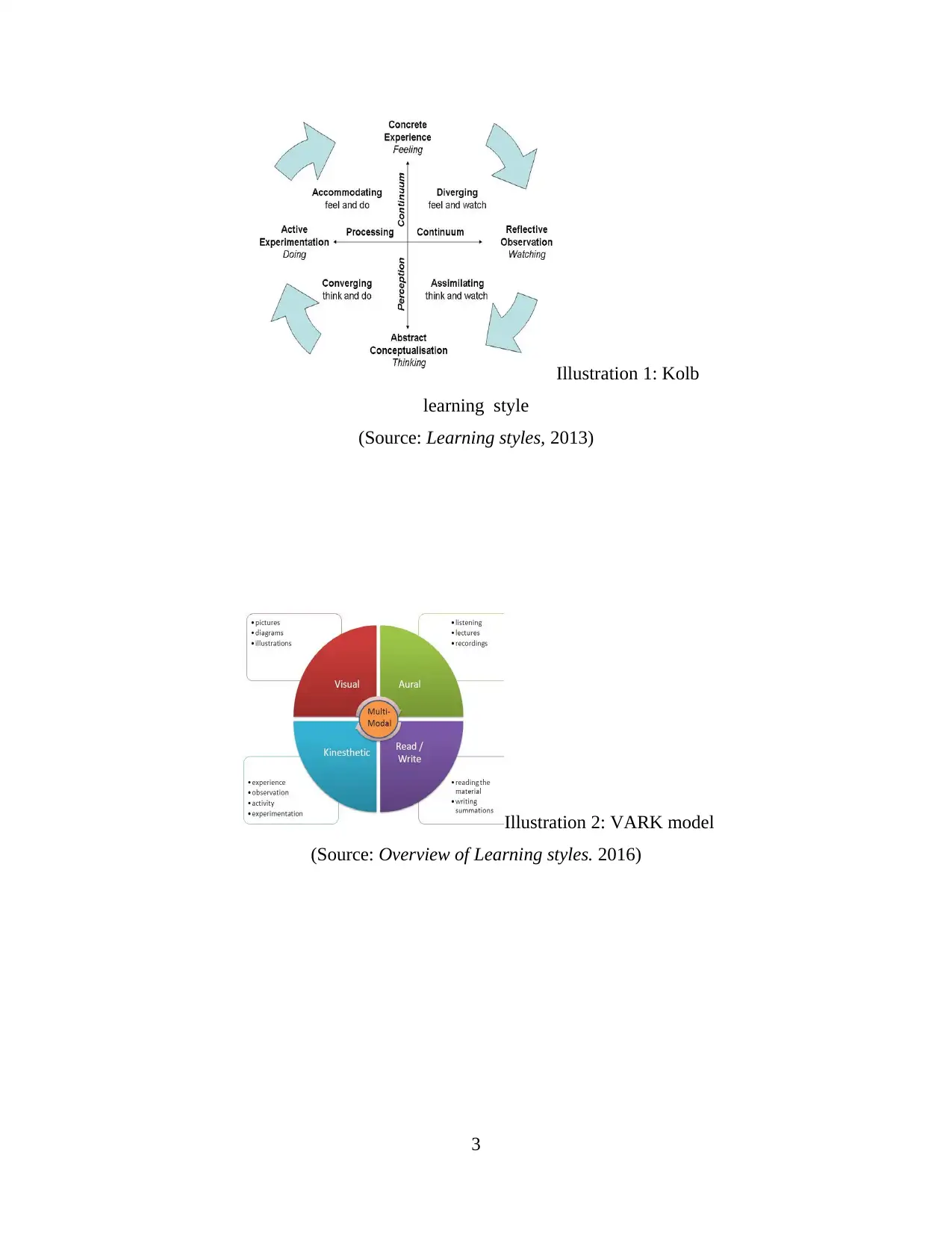
3
Illustration 1: Kolb
learning style
(Source: Learning styles, 2013)
Illustration 2: VARK model
(Source: Overview of Learning styles. 2016)
Illustration 1: Kolb
learning style
(Source: Learning styles, 2013)
Illustration 2: VARK model
(Source: Overview of Learning styles. 2016)
Paraphrase This Document
Need a fresh take? Get an instant paraphrase of this document with our AI Paraphraser
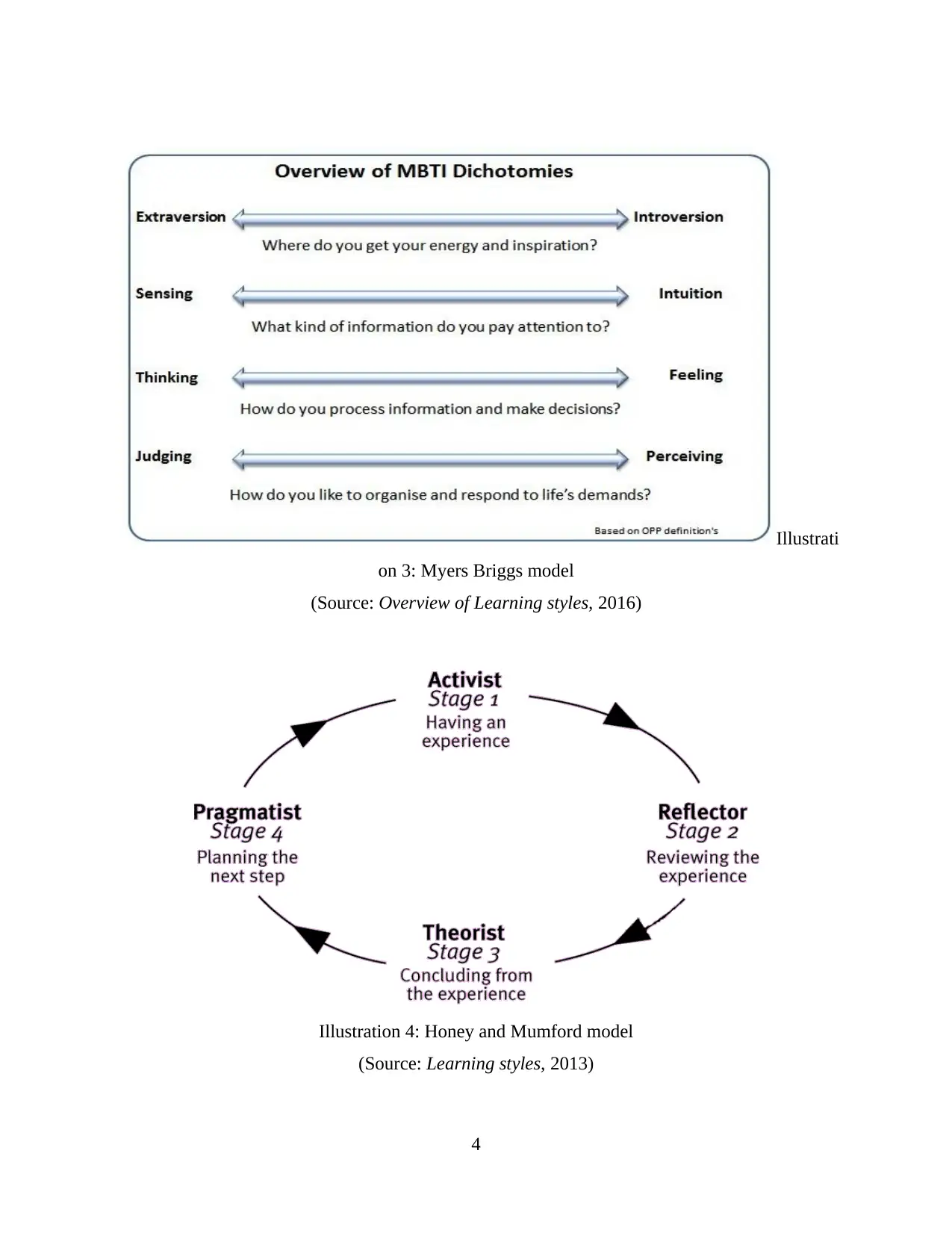
4
Illustrati
on 3: Myers Briggs model
(Source: Overview of Learning styles, 2016)
Illustration 4: Honey and Mumford model
(Source: Learning styles, 2013)
Illustrati
on 3: Myers Briggs model
(Source: Overview of Learning styles, 2016)
Illustration 4: Honey and Mumford model
(Source: Learning styles, 2013)
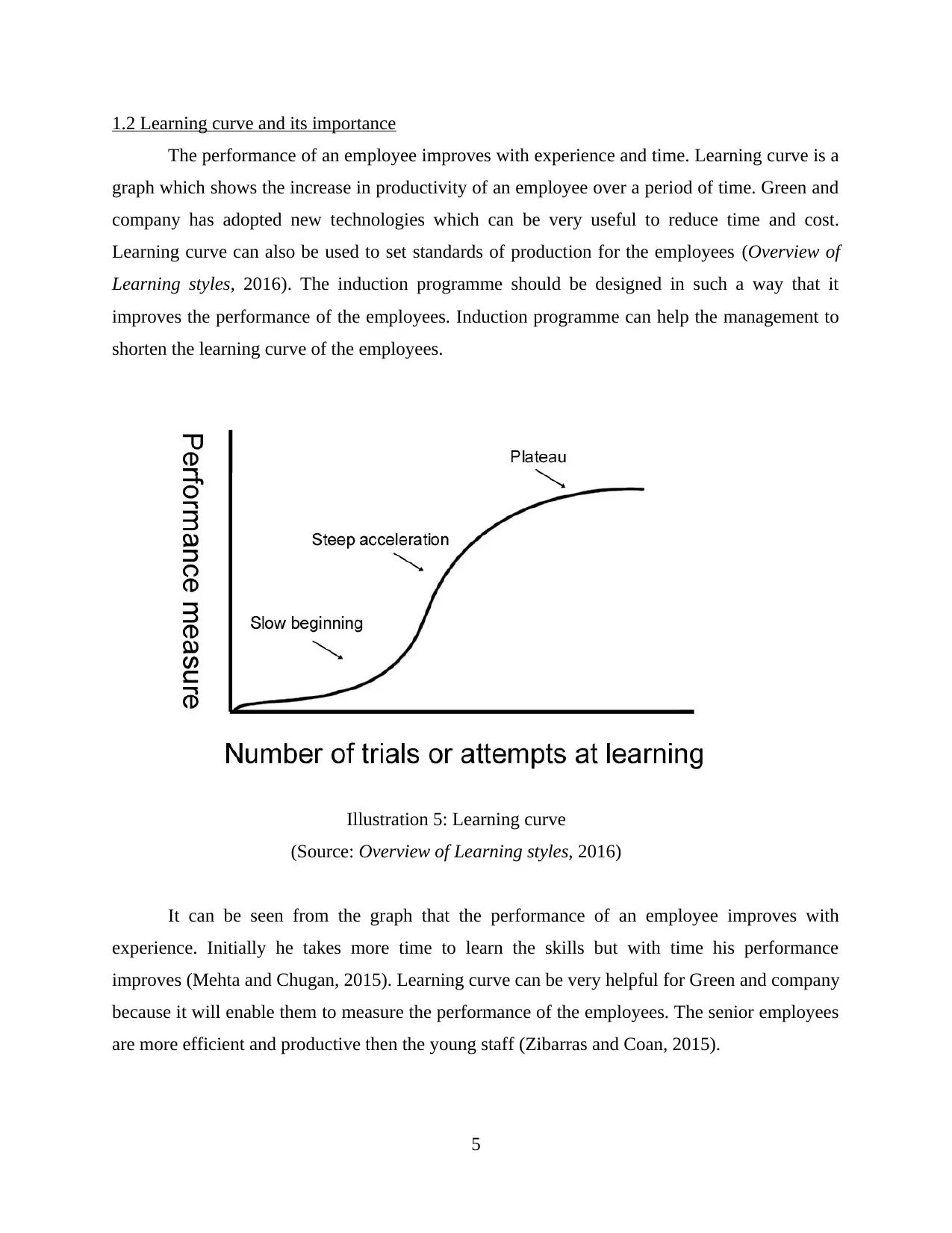
1.2 Learning curve and its importance
The performance of an employee improves with experience and time. Learning curve is a
graph which shows the increase in productivity of an employee over a period of time. Green and
company has adopted new technologies which can be very useful to reduce time and cost.
Learning curve can also be used to set standards of production for the employees (Overview of
Learning styles, 2016). The induction programme should be designed in such a way that it
improves the performance of the employees. Induction programme can help the management to
shorten the learning curve of the employees.
It can be seen from the graph that the performance of an employee improves with
experience. Initially he takes more time to learn the skills but with time his performance
improves (Mehta and Chugan, 2015). Learning curve can be very helpful for Green and company
because it will enable them to measure the performance of the employees. The senior employees
are more efficient and productive then the young staff (Zibarras and Coan, 2015).
5
Illustration 5: Learning curve
(Source: Overview of Learning styles, 2016)
The performance of an employee improves with experience and time. Learning curve is a
graph which shows the increase in productivity of an employee over a period of time. Green and
company has adopted new technologies which can be very useful to reduce time and cost.
Learning curve can also be used to set standards of production for the employees (Overview of
Learning styles, 2016). The induction programme should be designed in such a way that it
improves the performance of the employees. Induction programme can help the management to
shorten the learning curve of the employees.
It can be seen from the graph that the performance of an employee improves with
experience. Initially he takes more time to learn the skills but with time his performance
improves (Mehta and Chugan, 2015). Learning curve can be very helpful for Green and company
because it will enable them to measure the performance of the employees. The senior employees
are more efficient and productive then the young staff (Zibarras and Coan, 2015).
5
Illustration 5: Learning curve
(Source: Overview of Learning styles, 2016)
⊘ This is a preview!⊘
Do you want full access?
Subscribe today to unlock all pages.

Trusted by 1+ million students worldwide
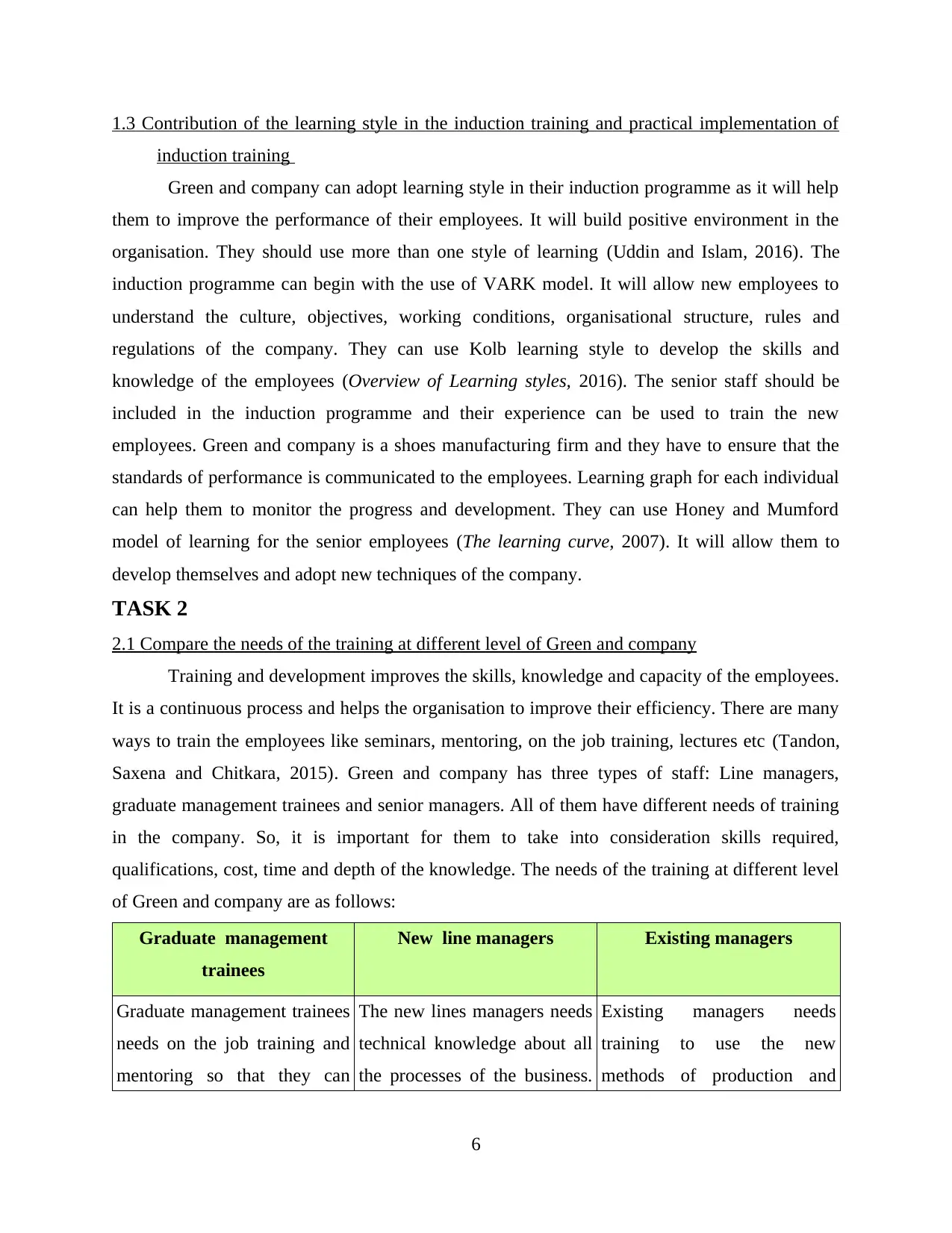
1.3 Contribution of the learning style in the induction training and practical implementation of
induction training
Green and company can adopt learning style in their induction programme as it will help
them to improve the performance of their employees. It will build positive environment in the
organisation. They should use more than one style of learning (Uddin and Islam, 2016). The
induction programme can begin with the use of VARK model. It will allow new employees to
understand the culture, objectives, working conditions, organisational structure, rules and
regulations of the company. They can use Kolb learning style to develop the skills and
knowledge of the employees (Overview of Learning styles, 2016). The senior staff should be
included in the induction programme and their experience can be used to train the new
employees. Green and company is a shoes manufacturing firm and they have to ensure that the
standards of performance is communicated to the employees. Learning graph for each individual
can help them to monitor the progress and development. They can use Honey and Mumford
model of learning for the senior employees (The learning curve, 2007). It will allow them to
develop themselves and adopt new techniques of the company.
TASK 2
2.1 Compare the needs of the training at different level of Green and company
Training and development improves the skills, knowledge and capacity of the employees.
It is a continuous process and helps the organisation to improve their efficiency. There are many
ways to train the employees like seminars, mentoring, on the job training, lectures etc (Tandon,
Saxena and Chitkara, 2015). Green and company has three types of staff: Line managers,
graduate management trainees and senior managers. All of them have different needs of training
in the company. So, it is important for them to take into consideration skills required,
qualifications, cost, time and depth of the knowledge. The needs of the training at different level
of Green and company are as follows:
Graduate management
trainees
New line managers Existing managers
Graduate management trainees
needs on the job training and
mentoring so that they can
The new lines managers needs
technical knowledge about all
the processes of the business.
Existing managers needs
training to use the new
methods of production and
6
induction training
Green and company can adopt learning style in their induction programme as it will help
them to improve the performance of their employees. It will build positive environment in the
organisation. They should use more than one style of learning (Uddin and Islam, 2016). The
induction programme can begin with the use of VARK model. It will allow new employees to
understand the culture, objectives, working conditions, organisational structure, rules and
regulations of the company. They can use Kolb learning style to develop the skills and
knowledge of the employees (Overview of Learning styles, 2016). The senior staff should be
included in the induction programme and their experience can be used to train the new
employees. Green and company is a shoes manufacturing firm and they have to ensure that the
standards of performance is communicated to the employees. Learning graph for each individual
can help them to monitor the progress and development. They can use Honey and Mumford
model of learning for the senior employees (The learning curve, 2007). It will allow them to
develop themselves and adopt new techniques of the company.
TASK 2
2.1 Compare the needs of the training at different level of Green and company
Training and development improves the skills, knowledge and capacity of the employees.
It is a continuous process and helps the organisation to improve their efficiency. There are many
ways to train the employees like seminars, mentoring, on the job training, lectures etc (Tandon,
Saxena and Chitkara, 2015). Green and company has three types of staff: Line managers,
graduate management trainees and senior managers. All of them have different needs of training
in the company. So, it is important for them to take into consideration skills required,
qualifications, cost, time and depth of the knowledge. The needs of the training at different level
of Green and company are as follows:
Graduate management
trainees
New line managers Existing managers
Graduate management trainees
needs on the job training and
mentoring so that they can
The new lines managers needs
technical knowledge about all
the processes of the business.
Existing managers needs
training to use the new
methods of production and
6
Paraphrase This Document
Need a fresh take? Get an instant paraphrase of this document with our AI Paraphraser
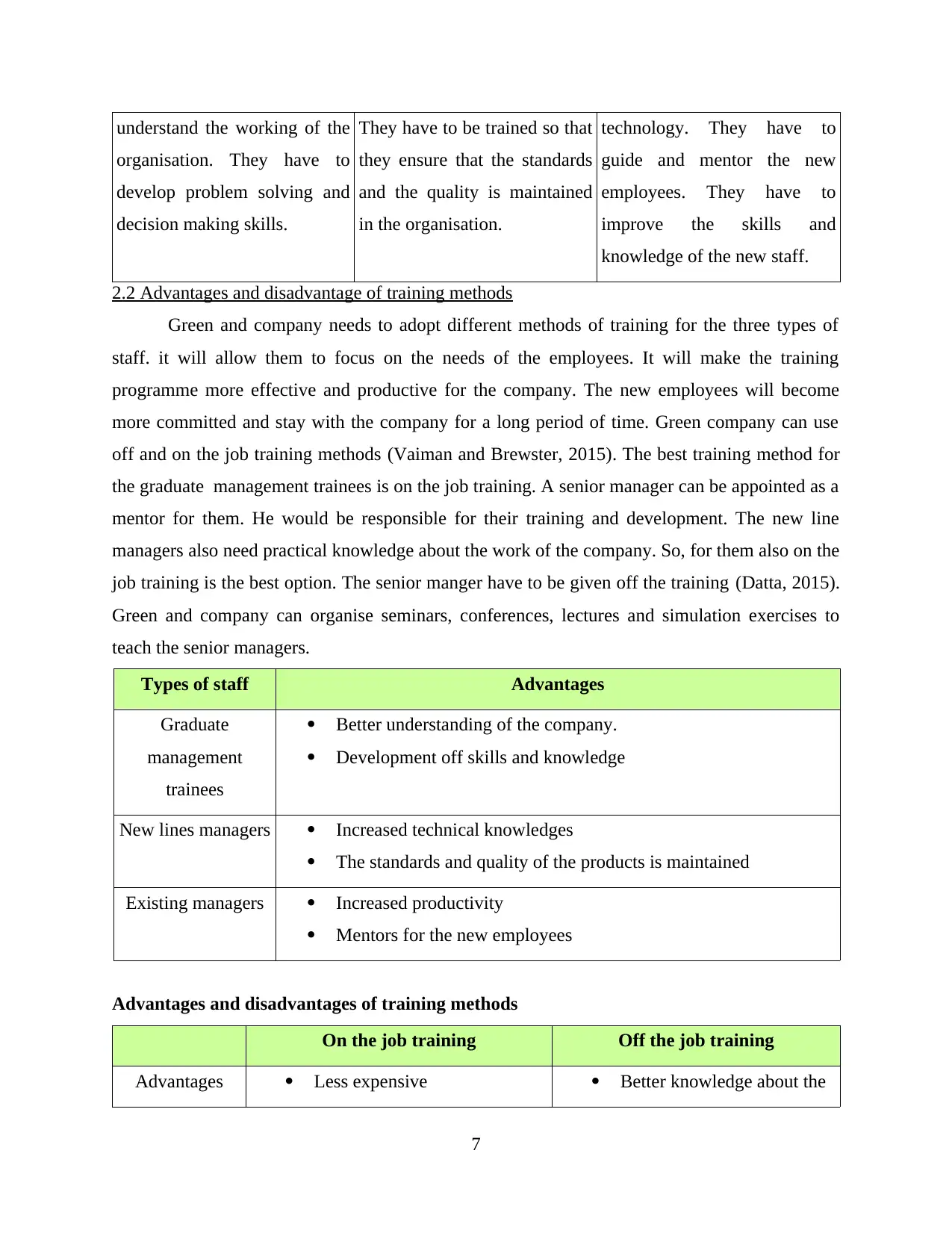
understand the working of the
organisation. They have to
develop problem solving and
decision making skills.
They have to be trained so that
they ensure that the standards
and the quality is maintained
in the organisation.
technology. They have to
guide and mentor the new
employees. They have to
improve the skills and
knowledge of the new staff.
2.2 Advantages and disadvantage of training methods
Green and company needs to adopt different methods of training for the three types of
staff. it will allow them to focus on the needs of the employees. It will make the training
programme more effective and productive for the company. The new employees will become
more committed and stay with the company for a long period of time. Green company can use
off and on the job training methods (Vaiman and Brewster, 2015). The best training method for
the graduate management trainees is on the job training. A senior manager can be appointed as a
mentor for them. He would be responsible for their training and development. The new line
managers also need practical knowledge about the work of the company. So, for them also on the
job training is the best option. The senior manger have to be given off the training (Datta, 2015).
Green and company can organise seminars, conferences, lectures and simulation exercises to
teach the senior managers.
Types of staff Advantages
Graduate
management
trainees
Better understanding of the company.
Development off skills and knowledge
New lines managers Increased technical knowledges
The standards and quality of the products is maintained
Existing managers Increased productivity
Mentors for the new employees
Advantages and disadvantages of training methods
On the job training Off the job training
Advantages Less expensive Better knowledge about the
7
organisation. They have to
develop problem solving and
decision making skills.
They have to be trained so that
they ensure that the standards
and the quality is maintained
in the organisation.
technology. They have to
guide and mentor the new
employees. They have to
improve the skills and
knowledge of the new staff.
2.2 Advantages and disadvantage of training methods
Green and company needs to adopt different methods of training for the three types of
staff. it will allow them to focus on the needs of the employees. It will make the training
programme more effective and productive for the company. The new employees will become
more committed and stay with the company for a long period of time. Green company can use
off and on the job training methods (Vaiman and Brewster, 2015). The best training method for
the graduate management trainees is on the job training. A senior manager can be appointed as a
mentor for them. He would be responsible for their training and development. The new line
managers also need practical knowledge about the work of the company. So, for them also on the
job training is the best option. The senior manger have to be given off the training (Datta, 2015).
Green and company can organise seminars, conferences, lectures and simulation exercises to
teach the senior managers.
Types of staff Advantages
Graduate
management
trainees
Better understanding of the company.
Development off skills and knowledge
New lines managers Increased technical knowledges
The standards and quality of the products is maintained
Existing managers Increased productivity
Mentors for the new employees
Advantages and disadvantages of training methods
On the job training Off the job training
Advantages Less expensive Better knowledge about the
7
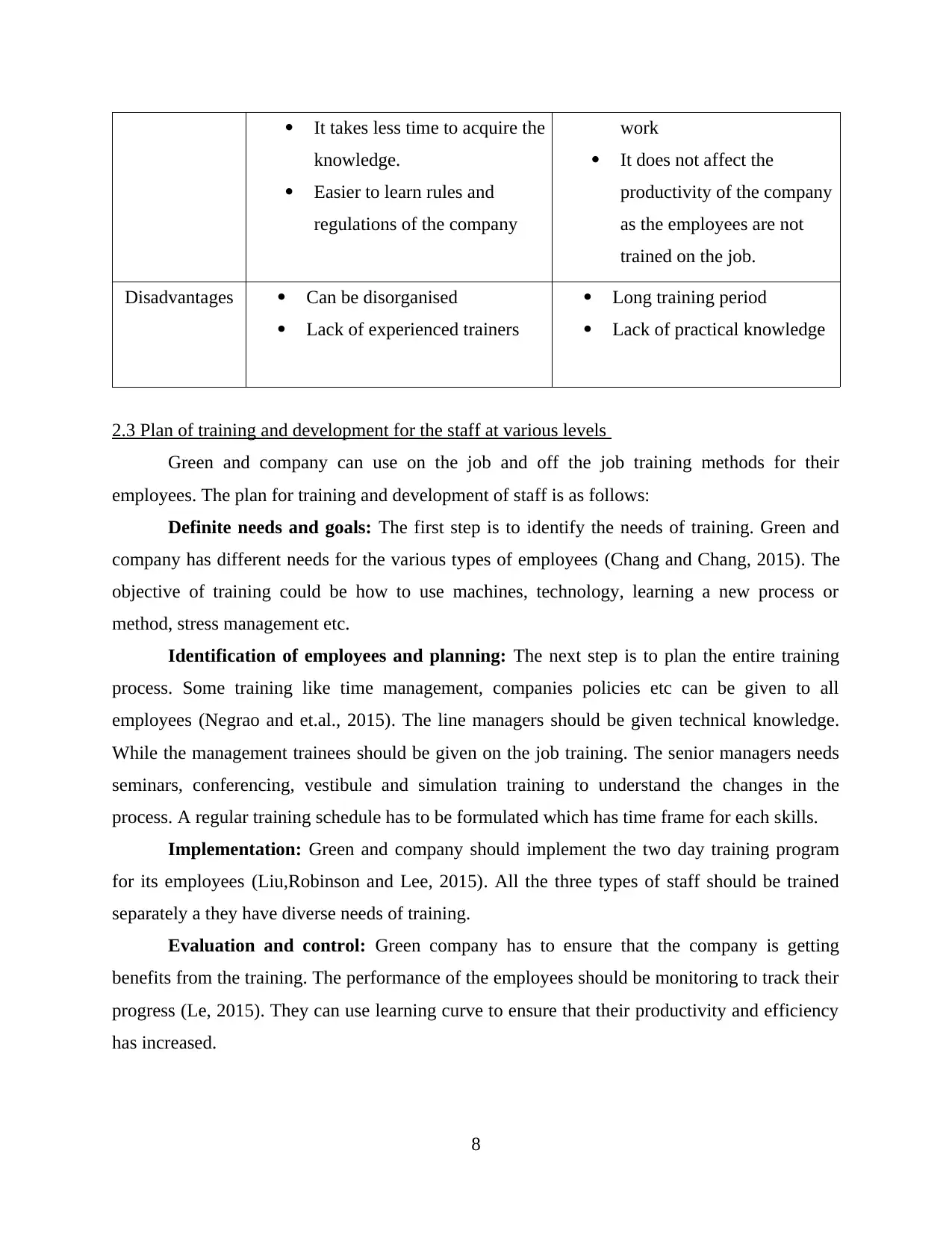
It takes less time to acquire the
knowledge.
Easier to learn rules and
regulations of the company
work
It does not affect the
productivity of the company
as the employees are not
trained on the job.
Disadvantages Can be disorganised
Lack of experienced trainers
Long training period
Lack of practical knowledge
2.3 Plan of training and development for the staff at various levels
Green and company can use on the job and off the job training methods for their
employees. The plan for training and development of staff is as follows:
Definite needs and goals: The first step is to identify the needs of training. Green and
company has different needs for the various types of employees (Chang and Chang, 2015). The
objective of training could be how to use machines, technology, learning a new process or
method, stress management etc.
Identification of employees and planning: The next step is to plan the entire training
process. Some training like time management, companies policies etc can be given to all
employees (Negrao and et.al., 2015). The line managers should be given technical knowledge.
While the management trainees should be given on the job training. The senior managers needs
seminars, conferencing, vestibule and simulation training to understand the changes in the
process. A regular training schedule has to be formulated which has time frame for each skills.
Implementation: Green and company should implement the two day training program
for its employees (Liu,Robinson and Lee, 2015). All the three types of staff should be trained
separately a they have diverse needs of training.
Evaluation and control: Green company has to ensure that the company is getting
benefits from the training. The performance of the employees should be monitoring to track their
progress (Le, 2015). They can use learning curve to ensure that their productivity and efficiency
has increased.
8
knowledge.
Easier to learn rules and
regulations of the company
work
It does not affect the
productivity of the company
as the employees are not
trained on the job.
Disadvantages Can be disorganised
Lack of experienced trainers
Long training period
Lack of practical knowledge
2.3 Plan of training and development for the staff at various levels
Green and company can use on the job and off the job training methods for their
employees. The plan for training and development of staff is as follows:
Definite needs and goals: The first step is to identify the needs of training. Green and
company has different needs for the various types of employees (Chang and Chang, 2015). The
objective of training could be how to use machines, technology, learning a new process or
method, stress management etc.
Identification of employees and planning: The next step is to plan the entire training
process. Some training like time management, companies policies etc can be given to all
employees (Negrao and et.al., 2015). The line managers should be given technical knowledge.
While the management trainees should be given on the job training. The senior managers needs
seminars, conferencing, vestibule and simulation training to understand the changes in the
process. A regular training schedule has to be formulated which has time frame for each skills.
Implementation: Green and company should implement the two day training program
for its employees (Liu,Robinson and Lee, 2015). All the three types of staff should be trained
separately a they have diverse needs of training.
Evaluation and control: Green company has to ensure that the company is getting
benefits from the training. The performance of the employees should be monitoring to track their
progress (Le, 2015). They can use learning curve to ensure that their productivity and efficiency
has increased.
8
⊘ This is a preview!⊘
Do you want full access?
Subscribe today to unlock all pages.

Trusted by 1+ million students worldwide
1 out of 22
Related Documents
Your All-in-One AI-Powered Toolkit for Academic Success.
+13062052269
info@desklib.com
Available 24*7 on WhatsApp / Email
![[object Object]](/_next/static/media/star-bottom.7253800d.svg)
Unlock your academic potential
Copyright © 2020–2025 A2Z Services. All Rights Reserved. Developed and managed by ZUCOL.





